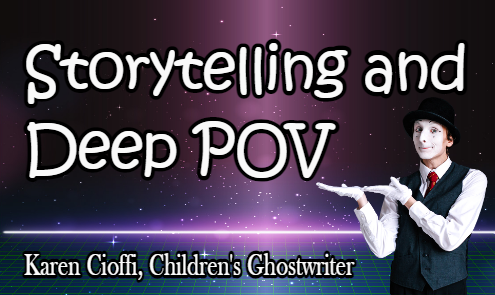Contributed by Linda Wilson
Do you write romance novels? Historical fiction? Mysteries? Whatever your genre, you strive to create a close personal relationship between your main character and your reader.
To shed light on this topic, at a recent New Mexico Society of Children’s Book Writers and Illustrators, SCBWI Regional event, Kimberley Griffiths Little presented the workshop, “Close Third Person or Deep Point of View, DPOV.” Kimberley has written many Young Adult novels, such as Forbidden, Banished, and for Middle Grade, When the Butterflies Came and The Time of the Fireflies. Also, as Kimberley Montpetit, she has self-published The Executive’s Secret, Unbreak My Heart, and many other books.
As Kimberley described DPOV, it is capturing your main character from the inside out. What she “knows, sees, hears, feels, experiences—filtered through her world. DPOV creates an immersive reading experience. In DPOV we see more of who the character is.”
Add to that a writer’s greatest prize: DPOV is how you gain THE VOICE.
Boot out the Narrator
I received one of the first drafts of my first book back so fast from a beta reader it wasn’t funny. There were few notes, few edits. But in huge letters on the first page she wrote: “GET RID OF THE NARRATOR! Then send it back to me.”
Oh my, was I in a world of rewrite! I think all authors would agree that finding that voice, showing and not telling the story, nixing the narrator, takes practice and experience. Also, I’ve talked to writers who agree that even in later stages of revision, “telling” and “the narrator” crop up and have to be banned. It has certainly happened to me. Examples offered at the workshop:
Narrator: She wished she could whisk back in time and redo the last few minutes.
Without the Narrator: Too bad life didn’t come with an undo button.
Narrator: He had to think hard about what to do next.
Without: What should he do next?
DPOV in Action
According to Kimberley: Become your character. Live inside your character’s mind and heart. Immerse yourself by staying in your character’s point of view. Take your reader on a journey through your character’s experiences. Want to see how? Here goes:
Shallow: Desiree’s skin prickled with pleasant excitement.
Deep: Shadows loomed. The place reeked of ancient secrets. Desiree’s skin prickled.
Shallow: He could see the tip of the dog’s nose peeking out of the closet.
Deep: Barry stepped through the door and entered the room. “Aha! There you are!” The tip of the dog’s nose peeked out of the closet.
DPOV is not italicized. According to Kimberley, italicizing thoughts takes the reader out of DPOV.
With italics: Jane looked out the window. Wow! Look at that sunshine and dew sparkling on the roses. What a perfect day for gardening. I’d better go get my tools.
She went to the garage and scanned her shelves. Now where did I put my gloves and trowel?
Without: Jane looked out the window. The dew on the roses sparkled in the morning sunlight. Wow! Would there ever be a better day for gardening?
Humming, she hurried into the garage. Her gaze searched the wooden shelves. Where had she stored her gloves and trowel?
Avoid “Pitfall Words”
Do a search in your manuscript and look for “pitfall words:” Think, Know, Feel, Realized, Caused, Made. Focus instead on the senses and play-by-play action in the NOW: Touch, Taste, Smell, Sight, Sound, Emotions.
Word No-No’s that create narrative distance:
- Saw, considered, made, caused
- She felt: watched, thought, realized, wished, decided, wondered
- Avoid prepositional tells: with, of, in
- Beware the IT Trap. It’s vague—(What’s vague? The It Trap! There, that’s better!) What does IT mean? Namely, that substituting “it” instead of specific nouns and descriptions isn’t nearly as dynamic.
- Choose power words
Workshop Tips Served up on a Platter
- Overuse of “to be” verbs
- Don’t summarize: Write the scene
- Share from the inside out rather than a “watcher’s” perspective
- Research physiological reactions
- Write moment-to-moment
- Break up long description with an action; break up internal dialogue with action
- Don’t name the feeling—Show the feeling by physical effects on the body, thoughts in keeping with that particular emotion: ASK HOW YOUR CHARACTER WOULD REACT
- Everything can’t be written in DPOV. Your reader sometimes needs distance to relax, such as your character reflecting and telling friends.
A word of thanks: Experienced and successful authors like Kimberley and others in our New Mexico Regional SCBWI chapter, who take the time to attend meetings and events and share their expertise, are appreciated by our members. To learn more about Kimberley, visit: kimberleygriffithslittle.com
Linda Wilson, a former elementary teacher and ICL graduate, has published over 100 articles for adults and children, and six short stories for children. Her first book, a mystery/ghost story for children 7-11 years old, will be published in September 2018. Currently, she is hard at work on Book Two in the series. Follow Linda at www.lindawilsonauthor.com.

Whether you need editing, rewriting, or ghostwriting, let me take a look at your children’s story. Just send me an email at: kcioffiventrice@gmail.com. Please put “Children’s Writing” in the Subject box. Or, give me a call at 347—834—6700
Let’s get your idea off the launch pad or your outline into a publishable children’s story today!

Writing a Fiction Story – Walking Through Walls Backstory
Picture Books – Story or Illustrations, Which Comes First?
Children’s Writing and Information Dump
Building a Writing Career Takes Practice and Focus


1 thought on “Deep Point of View”